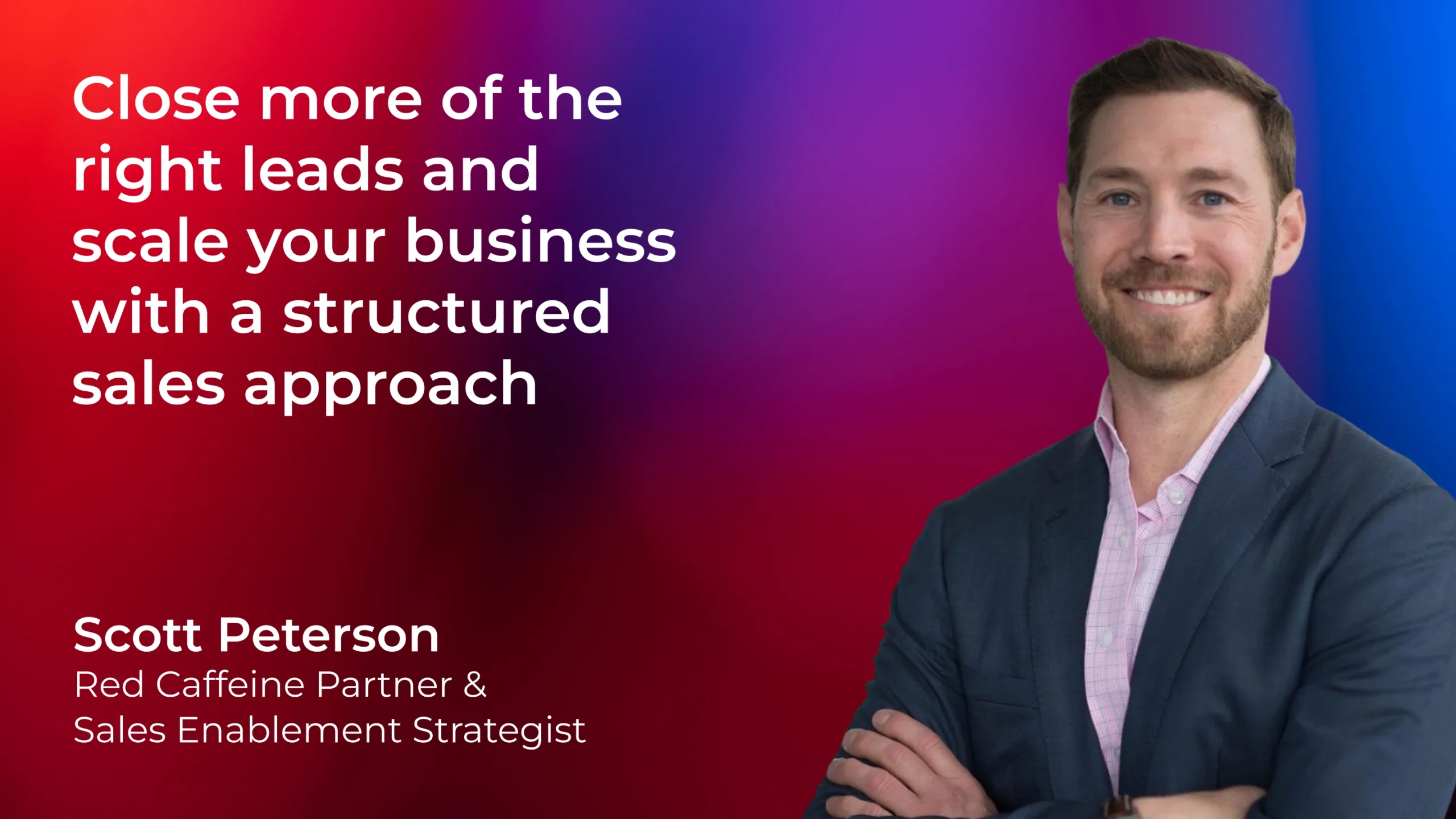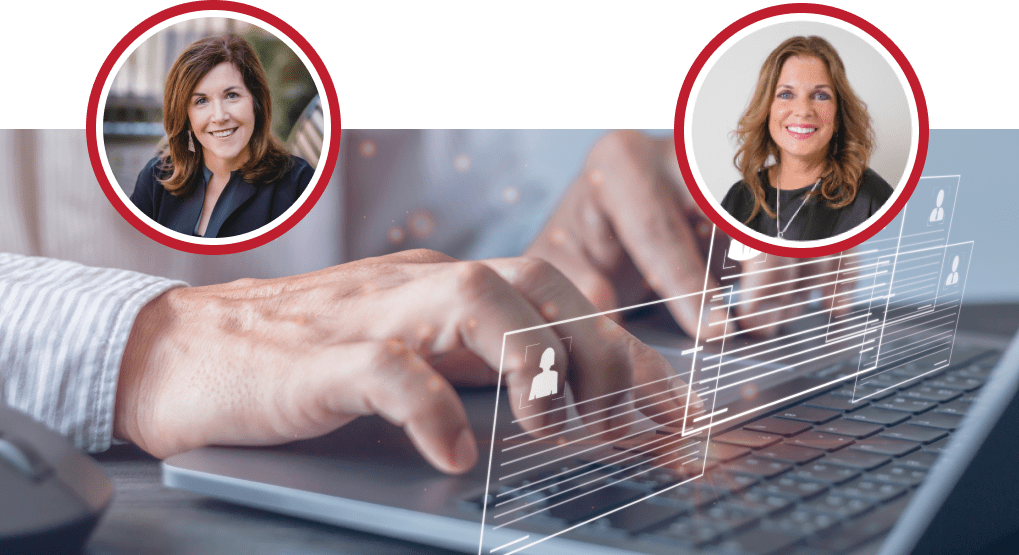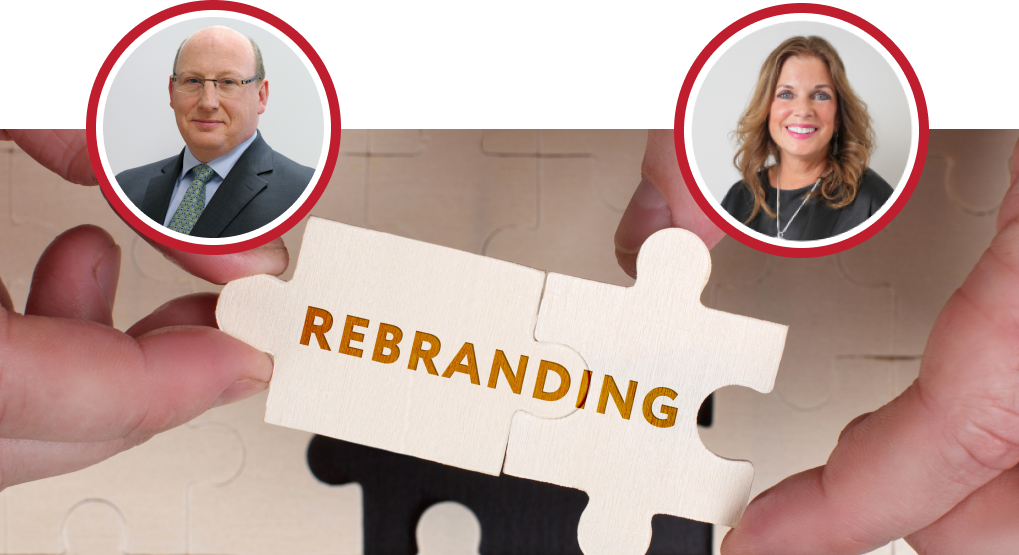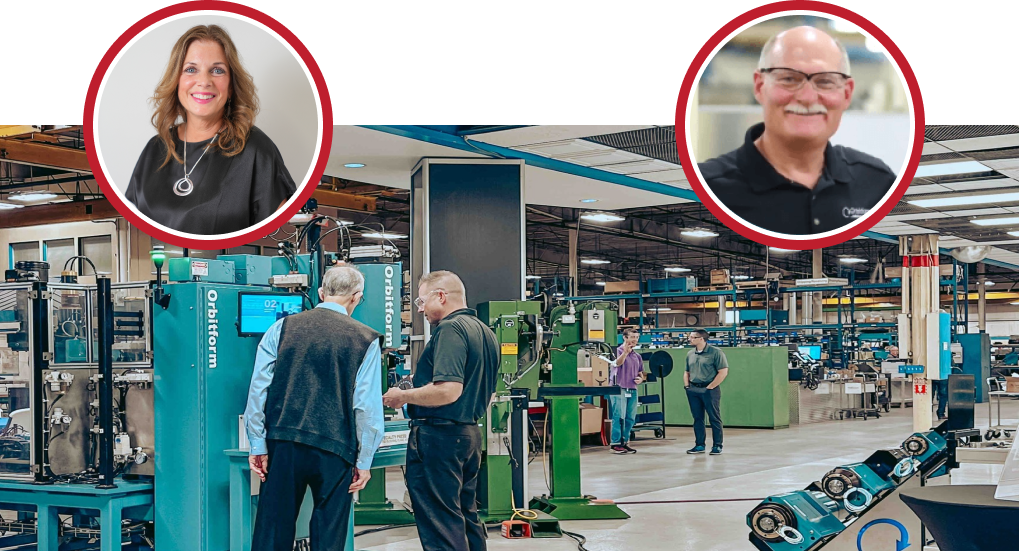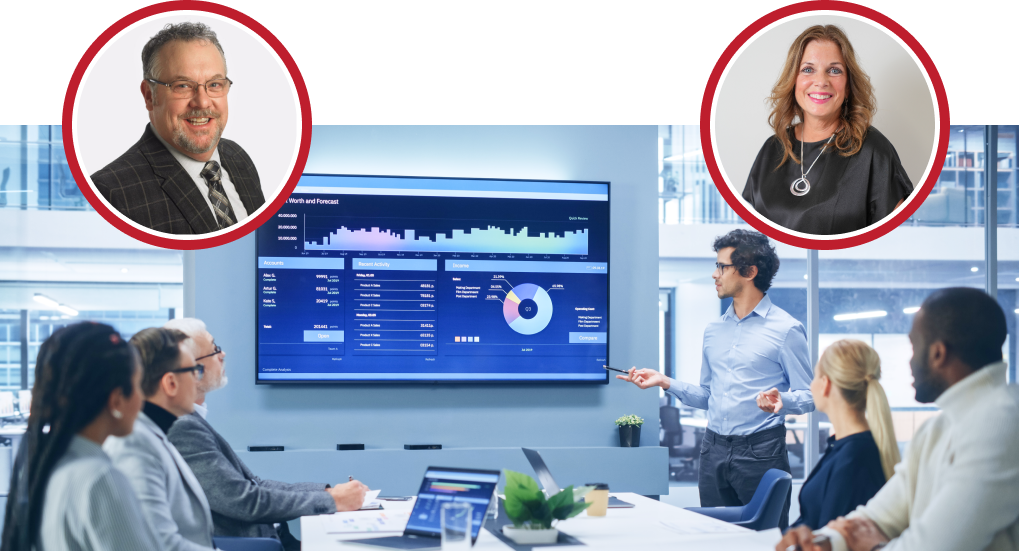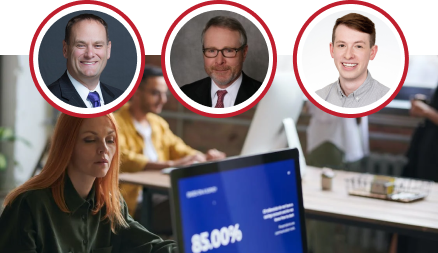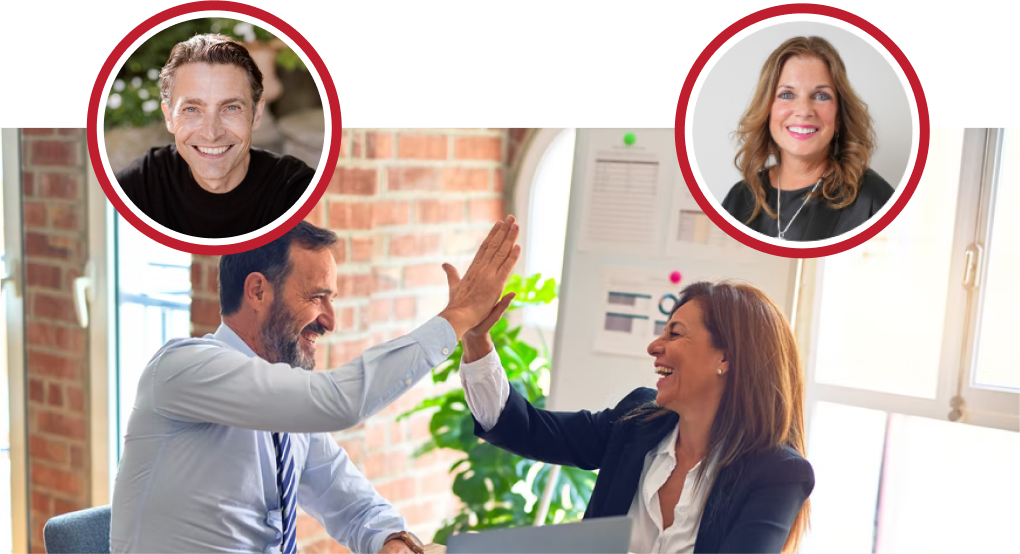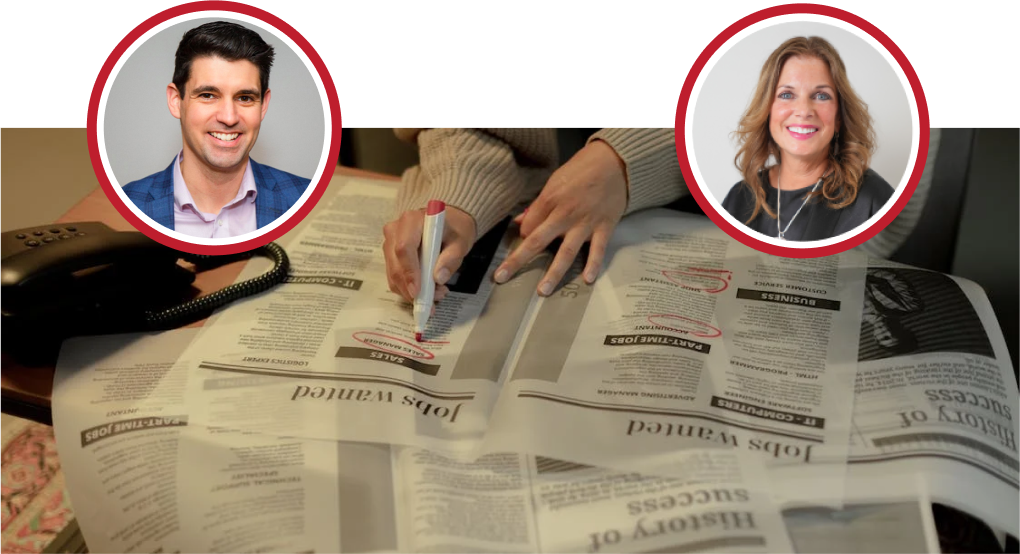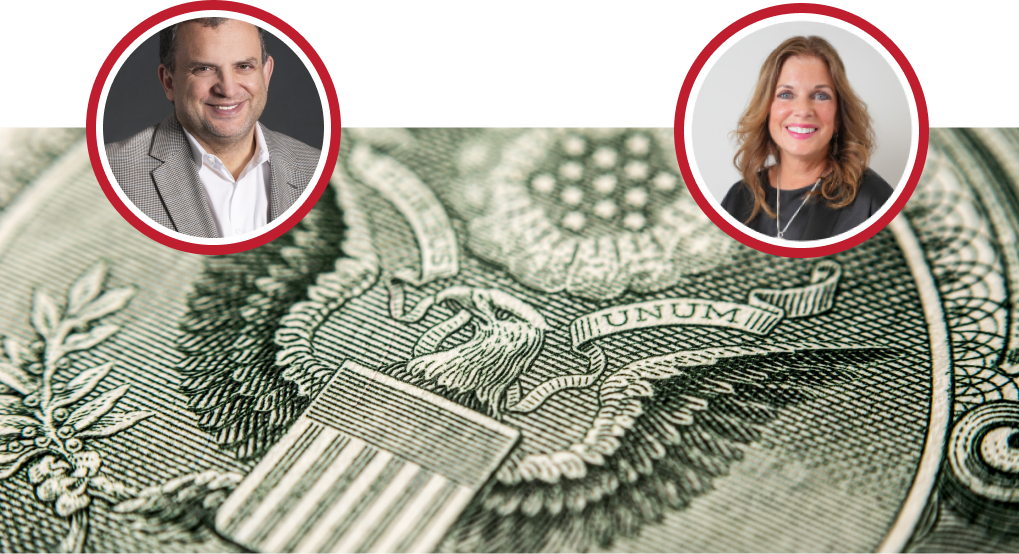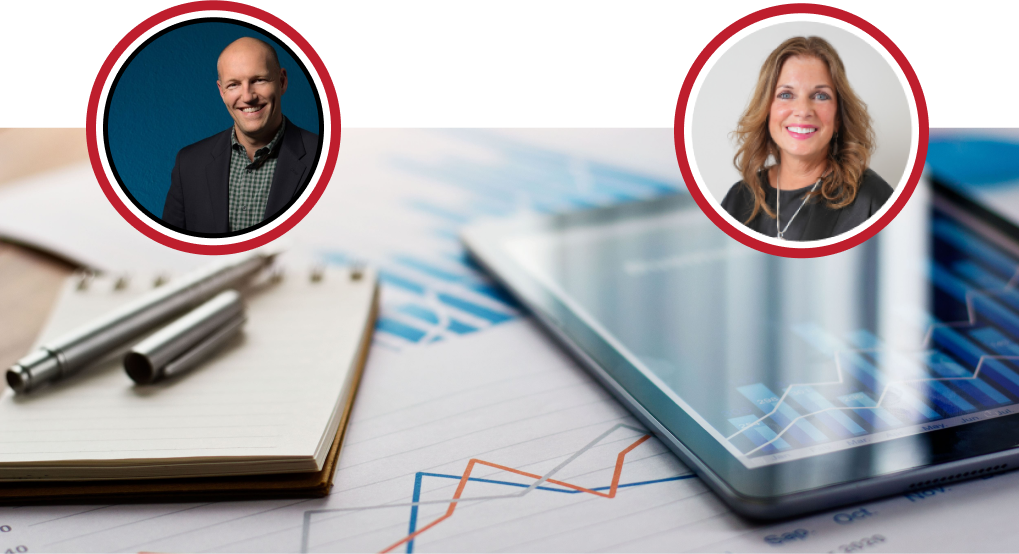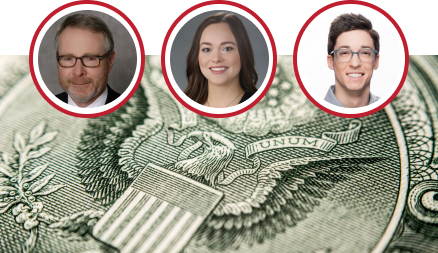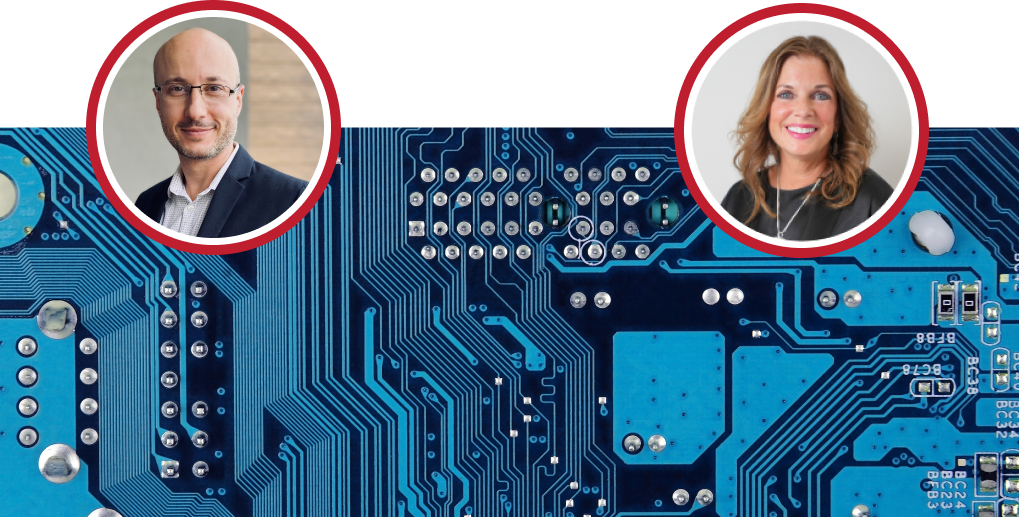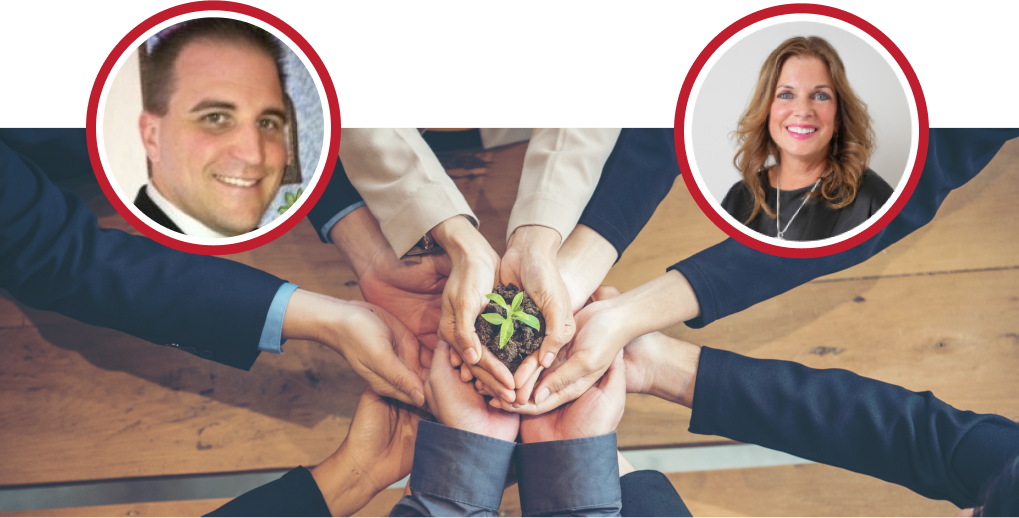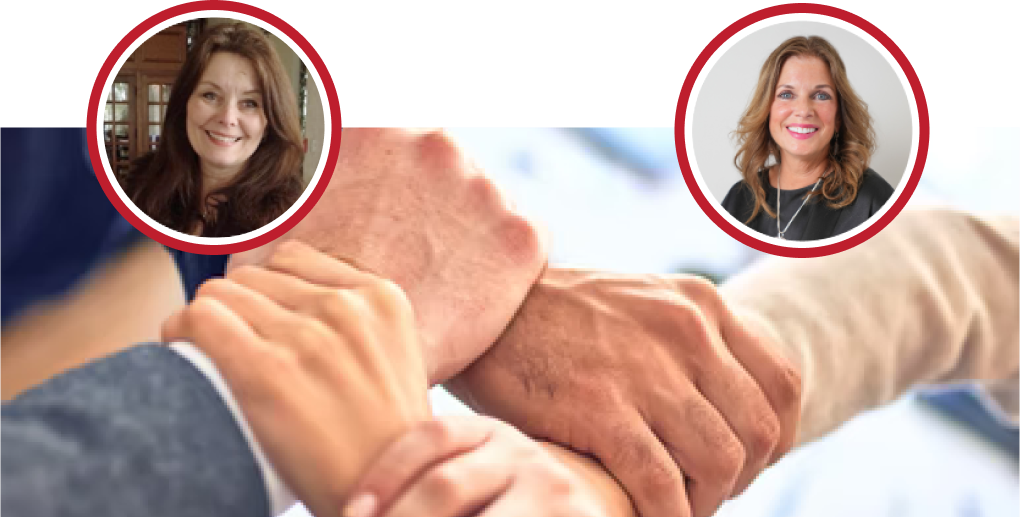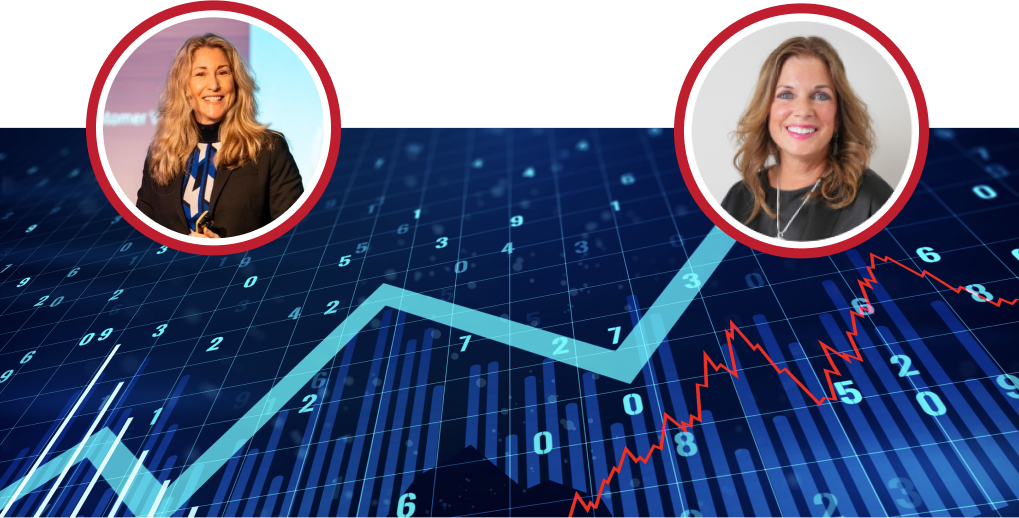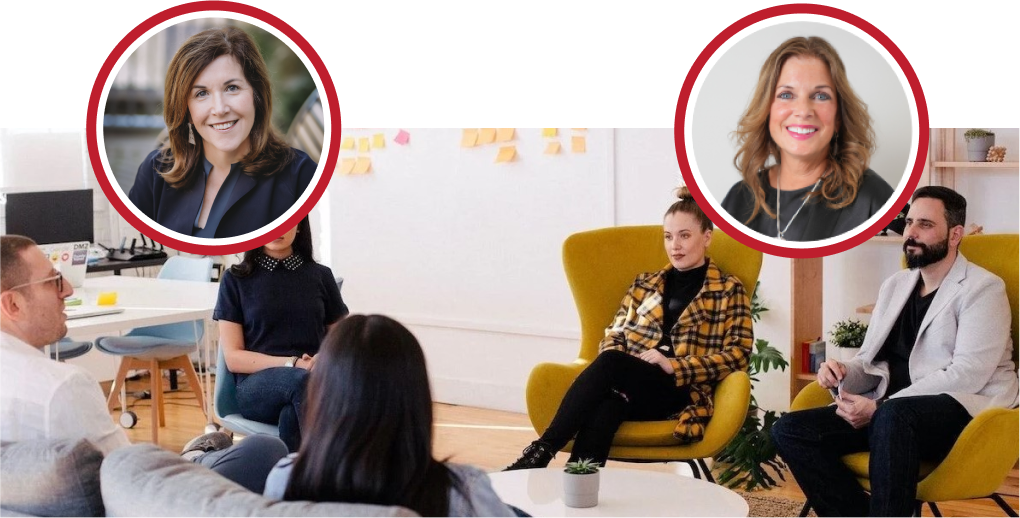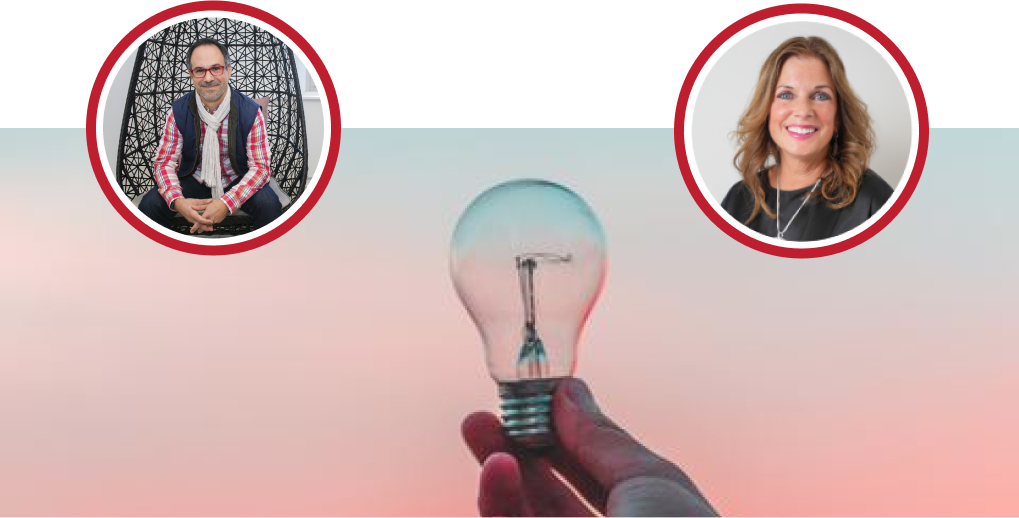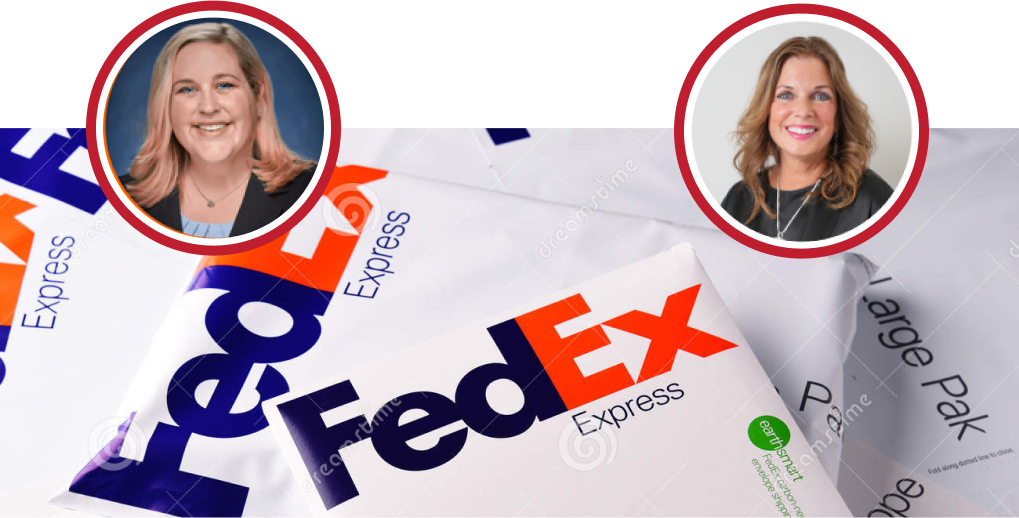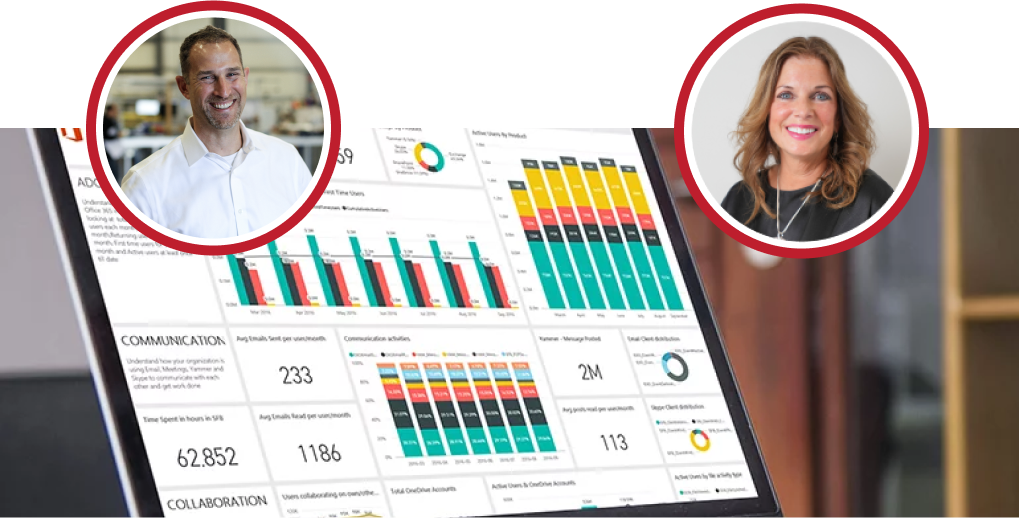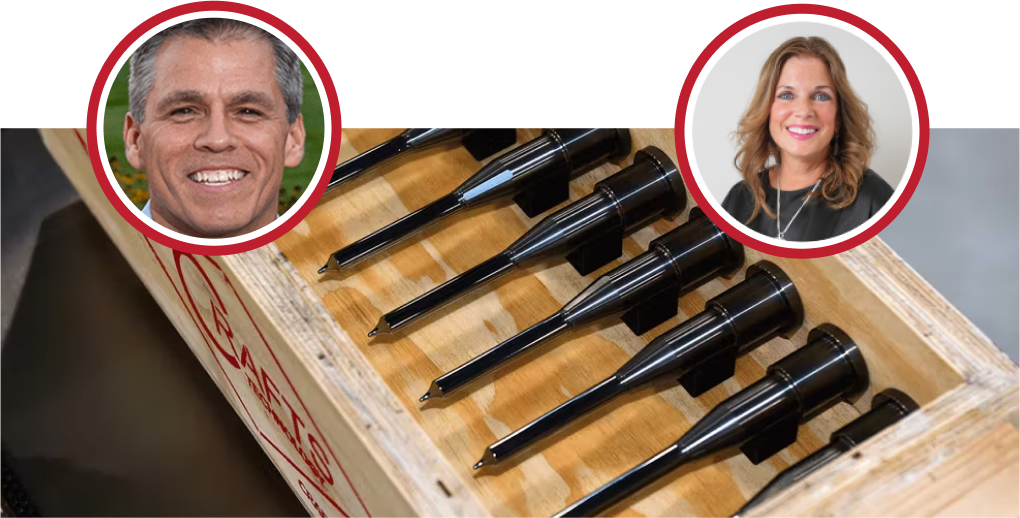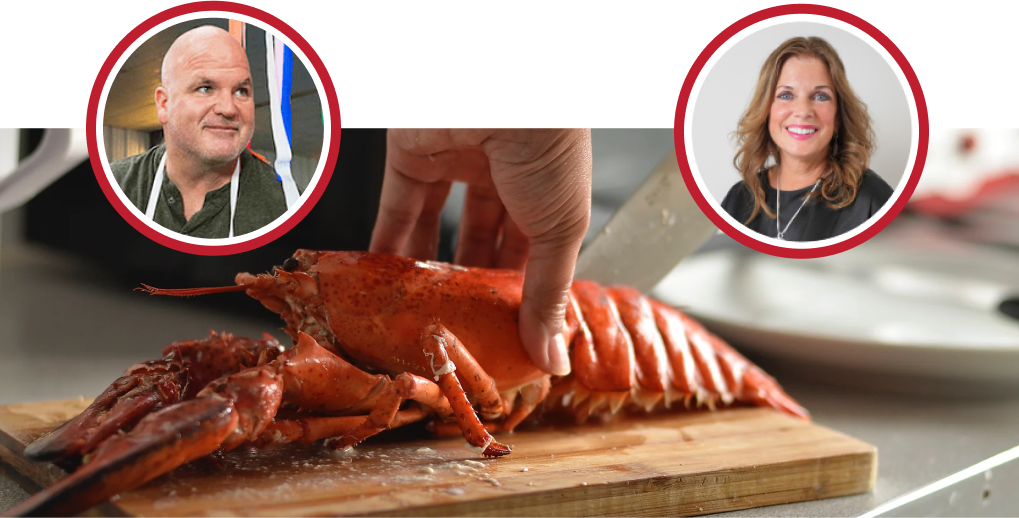Bill: All right, welcome everyone, uh welcome to the business as unusual live stream; uh you’re probably expecting to see red Caffeine CEO Kathy Steele here today; unfortunately, Kathy had to step away and has asked me to take over hosting duties my name is Bill Skorowski I’m the senior content marketing manager here at red caffeine which for anyone who doesn’t already know is a growth consultancy red caffeine we build badass brands that people want to work with and work for to learn more about our agency please visit www.redcaffeine.com, fortunately, I’m also not here alone today as we have Tom La Tourette a great friend of the show here to co-host Tom’s a managing partner and certified trainer at M3 learning which is also one of our wonderful sponsors Tom thanks for joining me welcome aboard it’s good to see you again I’m personally very excited to be hosting it yeah you bet.
Tom: This will be a great conversation, sorry.
Bill: Great great, this is a topic that is going to touch on a few of my favorite subjects, uh, buyer personas and customer research, so that means that I get to introduce one of the leading authorities on buyer personas and buying insights who is our special guest today Jim Krause Jim welcome to the show thank you also for being here.
Jim: Great to be here; thanks, Bill.
Bill: All right moving ahead uh Jim is the president of the buyer Persona Institute BPI has become the gold standard since 2010 for thousands of marketers in hundreds of companies when it comes to understanding buyers in order to give them confidence in the solutions that we want them to choose marketers like us at Red caffeine and other agencies use these insights when we create strategies and messaging to of course drive more leads improve more improve the conversion rates that we’re seeing and ultimately that helps sales hit their numbers I hope Tom can speak to that at some point in the show as well as a sales trainer uh Jim is also an avid blogger and I can’t recommend the buyer Persona Buzz newsletter highly enough I love it I know a lot of other people enjoy it as well but he’s also working on a second edition of the book buyer personas with BPI founder Adele ravela we’ll talk a bit about that later in the show Jim outside of work I know you enjoy traveling and sports and spending time with your family but I was curious if there’s uh maybe a fun fact that you can share with us that isn’t found in your bio.
Jim: Sure, and uh, let me just say thanks for having me. I’m super excited to talk about, you know, one of my favorite topics, buyer personas today um I guess I was trying to think about a fun fact for me, and the only thing that comes to mind is, um, I’ve been playing on a competitive men’s league softball team for the last 20 years we actually have a game tonight, and it’s just one of my passions it’s one of those things that just really helps me kind of decompress after her work day, and I’ve been playing with these guys for, you know, upwards of 20 years, so it’s something uh something I really enjoy, and I’m probably gonna have to give it up at some point, but I still enjoy doing it right now.
Tom: Now Jim from Chicago, being from Chicago, is it 16 inches or 12 inches are do you have all your knuckles, or is it the 12 inches?
Jim: Uh, I have all my Knuckles, yeah.
Tom: Okay
Bill: Jim, it’s funny you say that I just had a game last night. I’ve been playing as well for 20 years, so I understand we’re gonna have to give it up someday, but I’m not ready just yet.
Jim: Right.
Bill: Not quite yet. I thought since this is the first time uh I’m here, I might include a fun fact about myself as well; uh, while this is my first time hosting BAU, it’s actually not the most pressure I’ve ever felt uh, not even this week actually a few days ago I gave a presentation of a group of 10 people, and that was tough they kept interrupting me they’re asking questions I couldn’t answer, and they were not afraid to call me out when I slipped up so everyone please go easy on me today I’ll do the best I can Parker I think we have a slide from my presentation earlier in the week, but I will do my best to uh keep everyone up to date.
Tom: Uh, I was just gonna add something, just a fun fact I am a children’s book author, and I read to a class of fourth graders, and it sounds like they might have been the exact same audience as yours; they kept me honest and they also did not let me off the hook on anything.
Bill: Yeah, they don’t; that meeting I was referring to is actually the, uh, opportunity ahead to be the mystery reader at my daughter’s preschool, so those eyes don’t come off of you, and they have harder questions than I think we’ll get today so hopefully uh hopefully all this goes more smoothly than speaking to a group of three four and five years old.
Tom: Yeah, exactly.
Bill: Of course the reason that we’re here today having this conversation is to help our audience think a little differently about what their customers are experiencing throughout their journey ultimately that’s so that we can effectively sell to them whether we’re helping clients grow through new products or Services New Markets human capital technology or any of the nine growth lanes that we focus on at Red caffeine every strategy has to align with what buyers want and the best way that we have to learn what buyers want is through research I think Jim would agree with that one of the issues that I know I see personally and many of you watching probably do is that one of the reasons marketers and sales Pro struggle in this area is simply that they can’t agree on a on a basic starting point a definition even I think if you ask 10 people what a buyer Persona is you’re likely to get 10 different answers and if you if you were to see buyer personas from 10 different companies even if they’re selling to the same customers in the same Industry they would look pretty different from one another and how they’re created what information they contain and certainly how useful they are so I wanted to start by giving the gym the floor a bit to tell us a little bit about BPI and how it is specifically that this organization does so well focusing on such a narrow Niche that I think many of us unfortunately see overlooked every day so Jim tell us a bit about BPI.
Jim: Sure so uh buyer Persona Institute or BPI as we as we’re commonly called were founded about 15 years ago uh and quite honestly our fundamental goal or mission really hasn’t changed in all that time and it’s really to help marketers take all the guesswork out of what their prospective buyers need to know and experience to have full confidence in them and their solution right and that mission if you will was really born out of a it really kind of started with a frustration um and that is that you know many times marketers who are charged with trying to develop marketing and sales strategies messaging positioning where you really need to have a really in-depth understanding of your prospective buyers and the buying decisions they’re making we’re going to probably talk a lot about that today um are trying to do it with one hand tied behind their back because they really don’t have first-hand knowledge about what their prospective buyers needs are what are their concerns about a particular purchase what are they looking to achieve um how are they evaluating their options and who’s involved in the decision process just really basic information that can make the difference between really effective marketing and marketing that sounds like everybody else and is really white noise so we were founded 15 years ago really to use some very pragmatic approaches to develop buying insights that marketers can use immediately really just about anything they’re working on um so that’s why you know we remain as excited now as we did back then when we first started the organization and I think the thing I’m most excited about today is just an opportunity to talk about buyer personas maybe in a way that some of the folks listening in haven’t really heard before or if they have it’ll spark maybe some additional curiosity around how they can use buyer personas um really as a cheat sheet for all the marketing and sales efforts that they’re going to have going on uh in the coming years.
Bill: Yeah, you spoke a bit about the history of BPI and how it goes back so far, uh, in that time. I’m curious to hear how buyer personas have evolved and how the importance of them, perhaps over the last two to three, five even ten years, has changed. What’s your perspective on that?
Jim: Yeah so buyer I mean of course I’m going to be biased but candidly buyer personas how we look at buyer personas and we’ll talk about that more in a minute um are as important or even more important than they were two five ten years ago and there’s really a number of reasons for that um again when I say buyer Persona I’m talking about really understanding the buying decision very specifically and we’ll get into that but a couple of things that just come to mind is one is you know buying is not getting more easy right you hear a lot about how selling is hard um buying is hard too right particularly when you’re talking about high consideration products and services a lot of times buyers have never thought about a particular uh product or service category until they actually need it and right now they’re inundated with just so much information some of it conflicting some they’re just trying to understand and make heads or tails of and they’re looking for trusted advisors and providers that can help them so understanding the buying decision and what their needs are and their outcomes and their fears and concerns is super important now so that you can be laser focused so you can be very relevant with your buyers as soon as you can another big reason for it is what I want to call the you know kind of the indecision pandemic if you will and that is you know for folks that work with sellers quite a bit you know one of the biggest challenges they have is you know the dreaded uh no decision right and that that a lot of times we see that uh buyers just don’t really pick anybody they just end up choosing nothing and there was a book that came out a couple months ago by um uh Matthew Dixon and Ted McKenna called the jolt effect and they did this great research where they analyzed millions of sales uh conversations between sales and buyers um over the course of a year period and they analyze them and one of the things they found out is a lot of times there’s indecision it’s not because buyers prefer the status quo that’s kind of conventional wisdom um more than half the time it’s because they simply are enabled to make a decision and a lot of times it’s because they just have so much information and they’re just afraid of messing up they’re afraid of you know uh upsetting the Apple card if you will um so again another reason that you want to be really locked into what your buyer’s needs are so they look at you as the trusted advisor.
Bill: Um, you talk a lot about complex buying decisions, and I think that’s particularly relevant for the B2B audience; uh, Tom, I’m sure you’ve seen in your experience too that there’s a lot of Mis misperception around what a buyer Persona actually is and what it’s not I’d like both of you to speak to that actually if you could walk us through what you’ve heard included in buyer personas that is kind of shake your head at and wonder that’s really not that important and really at the end of the day what it comes down to that is most important to have your buyer Persona start with Jim and then Tom if you could come in from a sales standpoint.
Jim: Yeah so we have a very specific definition of what a buyer Persona is and what it’s not and it really makes quite honestly makes all the difference in the world so for us the common view of a buyer Persona or the or the view that a lot of folks have had is that a buyer Persona is if you will a fictional Avatar of an individual or a role that might be involved in a particular purchase decision so for example let’s say you sell CRM software and you may say hey we need a buyer persona for the CIO role because we think they’re going to be or know where they’re going to be involved in the decision process and you collect information about their age their education maybe even their overall priorities and challenges but that literally tells you nothing about the buying decision that they’re making around CRM um you’re still guessing at what they really need to feel confident in you and your solution so buyer Persona is really detailed information about what the buying committee for that CRM solution in our organization really needs to know and what they need to experience to have confidence in you and your solution big distinction and big difference between buyer personas that get used and buyer personas that don’t .
Bill: Yeah, I did, Tom; you can probably speak to that from a sales standpoint. How does a sales team interpret that in order to find something that’s useful from a buyer Persona in helping people.
Tom: We’re big Believers Bill and you know Jim talked about this issue we call it when you’re ghosted or indecision if we’re having trouble at the end of a sales cycle having somebody make a decision it means that we probably haven’t had the right conversation on the front end and it’s that space of really allowing The Client First we’ve got to understand the problem the issue the challenge that they’re having why they would even need this solution what’s going on you know what what’s causing them to pick up the phone start this research or even what would cause them to do it and one of the things we tell our sales people is you have to know the problem and you have to know the size of that problem and too many sales people it’s a push they just want to talk about themselves instead of learning about the client and if boy if you have that buyer Persona information ahead of time it really allows you to speak intelligently to the client maybe have a better understanding of what types of problems they’re encountering why they would need this solution and then you’re already in a validation conversation we teach folks especially senior level people they don’t want to be educated they want to be validated and knowing that buyer Persona allows you to see can my solution actually validate what they’re looking for so it’s critical I think in today’s selling World buyer personas and understanding of that are absolutely critical.
Bill: Yeah, now we’ve already got this slide on the screen, and Jim, I’d like you to touch on these key components. I think this really gets into the meat of the conversation because most people don’t think of the insights, and the process of buying is the most important part of the Persona, so Jim, I want to have you walk us through the Five Rings of buying insight as produced by BPI.
Jim: Sure so the Five Rings of buying Insight is you know that’s just a name we gave to it but what’s really important is these five categories of information um and I think for anybody in the Marketing sales or even product that are you know in the audience today I think hopefully this will be very logical to you I mean that’s one of the things that we like about using this approach so buyer personas basically have a few key components and you’re really trying to get buying insights around a specific buying decision so again wherever you’re sitting think about whatever product or service or cert products or services that you offer in the marketplace maybe hone in on one and what you’re looking to do is get insights in five key areas by talking to recent buyers that have made that exact same buying decision so imagine you’ve got a product um that you’re that you’re trying to figure out how do you market and sell better you’re going to go find people that made that exact same buying decision in the last six to 12 months and you’re going to interview them we’ll talk a little more about that perhaps later on but you’re looking to dig five key areas one is priority initiatives and prior initiatives are think of these as the trigger right so these are the reasons that somebody is starting their search and evaluation they’re even picking up the phone starting a Google search talking to a colleague whatever it may be um it’s likely they had this challenge or maybe opportunity for a lengthy period of time but what is the reason that now they’re really getting started and that’s so important because you want to meet buyers where they are and you want to know what is the impetus for this right again you know kind of going back uh to what we’re talking about earlier you want to be very relevant to them very quickly the second one is Success factors biggest success factors are these are the benefits or end results or outcomes that buyers want from making the investment in your product or service right at the end of the day what is the most important things that they need to achieve some of them may be very you know metric driven very hard and fast some of them may be much softer than that um you want to know what all of those are so that when you talk about results and outcomes you’re talking in the buyer’s terms you’re not talking about what here’s what my solution can do and all the things you’re talking about hey here’s how my solution can help you achieve your these outcomes that you care a great deal about uh the third one is perceived barriers this is one of my favorite ones because you know particularly for high consideration buying decisions that we were talking about earlier um you can bet that buyers are going to have some trepidation right this is potentially an a significant investment for them um they’ve they’re using something now that’s working for better or worse probably um there’s probably multiple decision influencers there may be a lot on the line if the thing works or doesn’t work and whatever they buy so you want to know what those fears and concerns are again ahead of time so that can they inform your marketing and sales um absolutely critical fourth is decision criteria and when we say decision criteria again think about the actual buying decision we are talking about what are the actual questions that you can expect buyers to have of you when they’re evaluating their Alternatives and the way you collect these is literally finding out how do they window down their choices you know this is we’ll talk about how we get this information but it’s not it’s not surveys and ratings and ranking it’s literally finding out what happened like what were the things that got you into consideration set what were the key questions and things they were looking at different uh competitive Alternatives that got somebody to stay in the consideration step or somebody or you got dropped out or you ultimately got chosen or not so understanding what exactly what those decision criteria is so powerful and then the last one is a buyer’s journey and buyer’s journey is steps and you know no buyer’s Journeys the exact same but by talking to recent buyers you can definitely pick up on some pretty significant veterans if you will as far as what are the key steps in their process what are the information sources they use and they trust to collect a point of view about what they’re looking at who are the influencers in the decision and who’s actually making that final decision now if you’re a marketer seller just think for a minute if you have this information think about the product or service I mentioned earlier you know think about if you had this information it was fact-based it was based on interviews that you recently did with recent buyers you’re taking all the guesswork out of this stuff right now you can focus all your time and attention you know on using your you know your creative talents um to really come up with some compelling things that that Buyers Say Hey these guys really get me right and then you can start becoming that trusted advisor and you start uh talking in their language.
Bill: Yeah, that’s such an important particular language.
Tom: This is so a powerful this place; this we see so many organizations struggle with starting this conversation, and because they don’t know this, they start a conversation about themselves instead of about the client, and that’s what loses energy in the deals, and uh Jim I you’ve nailed it I mean this is the Bible if you can start here this is exactly what creates energy what creates sales opportunities that don’t get ghosted and actually allow the client to go yeah you guys heard me you get me this is great.
Bill: And as we get to that point with these questions in these insights lead us towards is building a better buyer Persona profile, so Jim, I’d like you to speak a little bit about what those look like uh from the buyer Persona Institute, and I think we have a slide coming up in which uh we’ll lay that out in a template but talk a little bit about what we’ll see on the screen here in a minute.
Jim: Yeah so the buyer profile which we’ll uh will pull up is it’s really kind of we look at this page as the cover sheet for our buyer Persona um you may look at this and say hey that’s what our buyer personas actually look like today um for us it’s just a cover page and it includes um when we actually talk to recent buyers includes insights about people that are actually involved in the decision process so I know we can’t see it but if it comes up it includes things like you know what are the what are the roles and titles of the people that are involved in this buying decision um what is a typical education that they have uh what are their overall priorities not priorities specific to the this buying decision but just generally speaking what else is on their plate right so you can kind of get in their head a little bit say okay we’re focused on this buying decision they’re making but it’s really good to have that background and understand some of the other stuff um and then also we um it’s great to also have information sources as well um as far as information sources that they use and trust so here it is this came up a little bit late but this is really just a cover page to the buyer Persona so the Five Rings of insight I mentioned earlier that’s really the nuts and bolts of it this is just a way to get your head around like okay who are the decision influencers and you get those insights as well just kind of to complete your buyer persona.
Tom: You know, you mention the word trust, and I think that’s absolutely critical; the earlier you can establish trust with a client where they feel like they’re being heard, they feel like you understand their issue, their problem and you’re not just selling them something you know one of the things we talk about is buyers most of the time they want to buy they just don’t want to be sold and understanding this really takes you away from being a salesperson, and now you operate almost like a consultant great.
Bill: Yeah, and what we’ve seen a lot is there’s typically some reactive pushback when we ask companies about interviewing their recent customers and their prospects, and I’m not sure if you have a handle on where that comes from Jam or if you’ve heard it as well Tom but we can’t overstate how much value there is in customer interviews not only in developing personas but getting at the heart of things that we can’t otherwise learn so I’m curious how you approach uh Gathering those insights that feed into these profiles and um the rest of the information that becomes so important.
Jim: Yeah it’s really critical to get this information from recent buyers and let me just Define recent buyers because it’s helpful right because a lot of times we use the word buyers and customers interchangeably I would Advocate I’m not saying don’t talk to your current customers your current customer is going to be an invaluable source of information you may want to talk them to help um add some additional information for your buyer persona but if at all possible our recommendation is to talk to recent buyers ones that made that buying decision but aren’t necessarily your current customers some of them may be and that’s fine but you want to talk to folks that you would ideally have wanted in your sales pipeline right I mean that’s particularly from a new client acquisition standpoint that’s who you’re trying to attract right so go find recent buyers that have made that decision in the last 12 months and uh do in-depth interviews with them so what I mean by in-depth interviews is again not surveys and ratings and rankings per se there’s a there’s a place for that maybe that’s another conversation down the road we could have but what we’re talking about is 30 to 40 minute conversations the only scripted question we typically ask is take me back to the day when you first decided that you needed x and x would be whatever product service or solution that the focus is and tell me what you did first tell me what happened and then literally over that discussion walk them through the entire buying Journey from the moment they had an initial need all the way until they made that final decision find out how what information sources and how they people were put on the initial consideration set find out how they cut their choices you know a lot of times particularly for high consideration decisions they may be you know cutting their choices from a certain set down to you know maybe going from 10 to 4 to 2 to a winner find out how they did that what was that process like what information was critical you know what got people to remain in consideration versus not what kinds of fears and concerns you had did you have along the way all those kinds of things are going to fill out the information that we talked about earlier which is your five rings of buying Insight um and I can’t emphasize enough how important it is and if you if we could flip to the next slide just to make one last point about why interviewing recent buyers is so important is one of the things that you want include in your buyer personas if at all possible is not just the insights that I mentioned but also include actual buyer quotes from the interview that you do and the reason that’s so important is this is an example of a buyer Persona page for priority initiatives um so that was the first one that I mentioned which is triggers the blue stuff at the top is just buying insights and this happens to be for a large equipment manufacturer and you can see all the uh smaller gray font below is buyer quotes the reason including buyer quotes for all the insights that you identify is one it lends almost instant credibility to the findings right because your whole organization is going to say hey these are the folks that we really want to understand gosh who you know who is this I would have wanted to know about this opportunity right those kinds of things the second thing it does is it immediately lets you really get in the mind of the buyer you see how they talk about things you see how they discuss different vendor options you start kind of really feeling like you can feel their angst their pain their excitement about a potential purchase so it does a lot of different things that’s why these conversations are so important and for marketers that are nervous about it doing it or sells about doing at it there’s you know there’s resources that we can point you um that you can use to kind of help you know figure out how do I find these people how do I talk to them and do the analysis but go right to the source there’s really no reason not to.
Tom: I’m going to add, I think one other one other advantage to this is your client is this helps them justify the decision that they made and the reason they’re doing business with you; it probably cements that relationship at a really high level and if I’m going to ex you know we talk a lot about how do you land and expand in a business this is a really powerful way for them to see you as somebody who yeah I made a great decision here, and these guys are just confirming that decision I made, and I want to keep doing business with them it’s really great.
Bill: There’s a skill set there, Jim, that I hope you can touch on a bit; one of the reasons that I think we see so many companies struggle with this is that they just don’t have those investigative interview skill sets within sales and marketing I know my background’s in journalism so it comes naturally to me to ask those questions, but I know that’s not inherent to everyone um so I was hoping you could touch on what kind of person a company has to have or what type of people that buy a Persona Institute has that makes that successful as opposed to just asking a list of scripted questions as you mentioned earlier.
Jim: Yeah I mean this again this could we actually have a master class available on our website for those that want to really get into this and maybe get trained up a little bit on some of this stuff but let me just talk in Broad Strokes at least a couple of tips here um you know we’ve literally done thousands of buyer interviews over the years um so we’ve we know how to get to these people um wherever the buying decision is and how to talk to them but a couple of key things one is um go into it with an innate sense of curiosity right don’t go into go into the inner saying look the person I’m talking to has a has a story to tell right and they’re the nice thing about these interviews is you’re not asking them to pontificate about something right they’re literally telling you what actually happened um and they love doing it because the reality is this buying decision is probably something that was really important to them in their organization and it’s they really enjoy it’s actually telling you what happened so we always go into our interviews thinking like okay I’ve got the Five Rings of buying inside in mind those are the things conversation points I need to get to we also go into it making sure that we’re always asking probing questions so let me just give you one example of that if somebody says it was really important that the you know let’s say it’s a technology product it was really important that the technology product was easy to use what do you mean by easy to use right if you follow up with a question and then they will tell you specifically what they mean by ease of use ease of use it could be in this case you know non-i-t quote-unquote business users are able to use it very quickly and the training is very straightforward and user interface is really easy to use right so do follow-ups right so never take them at the first answer because there’s always a second and third sentence so have the patience to kind of talk through it and make sure you understand it and one more tip I can give you is you know some folks ask us well how long are the interviews and they’re typically 30 to 40 minutes but my best barometer of the end of an interview is when I feel like I literally understand everything that happened in that particular buyer’s journey and why it happened and why it was important and if you have those questions in mind you almost become very effective at asking questions and probing um because it’s just natural right it’s just natural conversation.
Bill: From a sales training standpoint.
Tom: Go ahead, Bill. I’m sorry I was going to ask you a quick question but go ahead.
Bill: I was going to ask how that factors in from a sales standpoint; those are a lot of questions that I’m sure salespeople should be asking, or I like them, to be honest.
Tom: Yeah, they really should, and I love the I love what you said, Jim, it’s all about being curious, and the more Curious I am, the less I want to tell, the less I want to sell, the more I want to learn um I gotta think Jim when you approach it that way that many times those 30-minute meetings turn into 45-minute meetings 50-minute meetings hour and a half because people want to talk about themselves and what they the decisions they’ve made especially at higher levels in an organization.
Jim: Yeah, we booked them for 30 minutes usually, but I would say eight out of 10 times, we’ll ask them as we get towards the interview because we haven’t gotten everything we need we’ll ask them if they can hang on for a few minutes and unless they have a really hard stop they almost always give us the time because again they’re enjoying the conversation.
Bill: I know, I know we have a hard stop at the top of the hour, so I saw a really good question come in through the chat, and I wanted to give you a chance to answer that; no, Jim, the question was how do you get a non-customer to give up that kind of time to share when they have very little invested in you and especially when they don’t have a lot of time with their own suppliers any advice in response to that question.
Jim: You pay them is this is the short answer um and I don’t mean I’m saying that kind of tongue-in-cheek but the reality is you know this is this is research right you’re doing research with Buyers there’s all kinds of different market research studies that you can do but this is research with Buyers at the end of the day and folks are very used to um particularly in today’s world particularly in the business markets folks are very used to uh being asked to have discussions and paid discussions for that matter so what we do is um we work with some of our recruiting partners that we’ve worked with for years um we give them very specific screening requirements about who we want to talk to or not talk to depending on a particular study they help us find those folks and then um we offer incentive for them to participate um and they a lot of times what we do is we let them uh donate it to a charity if they’d like because their organization may not like let them take the money directly or they’re just not comfortable doing it and that’s totally fine sure um but that’s generally the way we do it the other way you can do it is you can also offer them a certain piece of thought leadership material as well or some type of you know high level insights about the study we don’t do that as much but usually monetary is really the way to go and it has been for quite honestly decades.
Bill: Sure, so let’s say you’ve gotten to the point where you’ve developed your buyer Persona.
Tom: Can I answer before we go off of that because I think this question is really important, um.
Bill: Yeah, go ahead.
Tom: You know, what we see is just too many salespeople don’t ask the question because they think they won’t get the time; now imagine if I’m doing business with a supplier and they’re not asking me these types of questions if I’m not if I’m just coming in to learn about your business and I start asking these buyer Persona questions I’m gonna be here you know I’m gonna feel like you’re somebody who hears me understands me and you’re not here to just sell me something and especially if my supplier is not asking me these questions it’s going to differentiate you in the field I don’t know if Jim would you agree with that.
Jim: No question about it; in fact, when we talk to some of our clients, the first question I’ll ask them is, you know, tell me what you know how what you view as a buyer Persona and what kind of value you’re really trying to get out of it you know before I start talking about any of this stuff we gotta you have to know what they’re trying to what’s their end objective what are they trying to do so that’s and again it gives immediately gives that Prospect confidence that you care about what they’re trying to achieve and you’re in your the next logical step is we’re going to figure out a way to help you.
Tom: Yeah, exactly, yeah, you’re not just trying to sell me something; you’re trying to solve a problem that I have; you’re trying to fix something, and most of these organizations, if that problem is big enough, I’m gonna find the time because I have to fix that I have to solve it I have to move it along.
Bill: It’s really about that pain is the pain great enough that’s going to cause you to act, or is it not and that goes back to the initial point that Jim made about what the trigger is; why is it that you’re solving that problem now as opposed to you’ve probably had this problem for six months but why is it today that we’re talking about solving this problem, why has it become such a big issue that you can’t wait anymore to do that .
Tom: We call the difference in most organizations below the line and above the line, and so if you were to think about your c-level focuses above the line, but everyone of every above the line person, as we call them trains, they’ve got five or six High priorities that they have to fix they have to solve and a buyer Persona helps you understand what those possible trains might be and then you can see how you fit inside of that and now we’re having a conversation about the problem instead of about the solution.
Bill: Yeah, so I want to move us forward into what organizations do next once they have developed a buyer Persona, whether it’s with the Institute or an agency like us or someone else; what should they do after that once they have this profile where do they go from there.
Jim: Um so two things one is a lot of times you’ll know what to do with it like when you have a buyer Persona and you have these insights and you’re in Marketing sales profession you can’t help with but come up with ways to start using it right immediately you know messaging as an example like right away you’re gonna have you can have a really good understanding about what buyers want so that’s number one but the second thing just to be a little more specific and thank you for putting this chart up um and this is something we can’t recommend enough if you have the discipline to do it and you can get the right folks in your organization to do this exercise um would encourage a workshop if you will or a couple of meetings if you will to figure out what I’m showing on this diagram so this is a simple Venn diagram this the red circle on the left is what buyers want and need these are all the insights that you got from your buyer Persona right they’re all the five things we talked about earlier the triggers the outcomes you want what are the fears and concerns they have how are they going to evaluate you what’s their steps in the buyer’s Journey so you’re going to have that red circle you’re going to be Rock Solid on it the right hand side is the other side of the equation what is what does your company do and what do you guys do well right and you want to find the intersection between those two so what we recommend doing is taking each of the insights that you find in your buyer persona and then mapping it to your organization in two ways number one is come up with a determination about how important you eat you think each one of these are each one of these different maybe they’re all important maybe some are more important than the other you can definitely use your own institutional knowledge about that or there’s other ways you can get it the second thing we recommend doing is once you’ve got those insights if you will figure out which you think differentiate are really differentiating right because you could find that you know let’s go back to that example I gave earlier like ease of use is really important but you say you look at the market and some of the competitors out there and you say well we really can’t differentiate much on that because either a everybody kind of does a good job on it or most people do or B it’s a weakness for us it’s something we’re not actually good at so what you want to do is find that sweet spot what are the things you know buyers want and need very badly what are the things that you do really well and develop message themes around those things and the reason that’s so important is because now from a marketing and sales perspective you go out to Market and you feel confident that buyers want it and need it and you feel confident in your story right because you know you’ve done the homework to do that mapping and you know uh Tom can probably attach a lot of times one of the biggest challenges sales folks have is trying to figure out you know what do I talk about you know give me two or three dot points to talk about well here’s your dot points right here’s some things that we did our homework on and we can feel pretty good that your buyers are going to have this need and we did our homework and here’s the story you can tell right so you can use it in marketing you can use it in sales so that’s a great way to get started and make it from you know this vast pool of buying insights into all right what do we really want to focus in on that’s going to be right for our organization so that we can put ourselves in the best light in meeting our buyers needs.
Tom: Really great.
Bill: It’s incredible to see that Venn diagram because that’s exactly how we address content marketing at Red Caffeine; we have a Venn diagram that our clients would recognize that on the red circle, as you have here, it’s what do customers want to learn what do they need to find out now on the other side it’s well what do we do best what where is our center of influence where’s our thought leadership in that sweet spot in the middle is where we focus the majority of the content let’s make sure that we’re speaking to the needs of the buyers but also the strengths of our organization so that’s a perfectly familiar way of looking at it and I imagine that applies to a lot of different areas where you’re considering both your outside audience and what you do very well so I appreciate you sharing this here.
Tom: Yeah, it’s really the difference, like in me, I’ll hear a lot of salespeople, hey, what keeps you up at night? That’s the difference between that question and, you know, what we’ve seen from somebody at your level in your Industry like yours or with your Persona; you’re there, our existing clients are telling us that they’re worried about this issue, this issue they need to fix this which one of those three is keeping you up at night that’s a completely different question right, and if you can ask a question like that with this information the customer is going to say wow these guys kind of understand my business they kind of understand my needs now let me give them more information let me share what I’m struggling with instead of the first question is somebody kind of fishing for a solution that they’re going to try to sell me at.
Jim: And if you do this correctly, if you go all the way with this, it’s great to also develop your proof points right so you come up with your message themes; when we work with clients, we typically come up with four five six at the most like overall themes and the detailed stuff is in the proof points right so ease of use again using that example right that’s kind of a broad category but an important one a lot of times particularly for technology stuff, but you may have four or five great proof points around that right and now you’ve armed your sales force, and you’ve really focused your marketing efforts around those proof points.
Tom: Helps me become a better Storyteller; it helps me really, and yeah, it’s really powerful.
Bill: Let’s continue down that track before we wrap up with another audience question. I think it makes sense to talk about what outcome we see here, what difference there is, uh what sorts of results organizations should expect to achieve when they Leverage What We Do consider more modern buyer Personas, whether it’s in their sales or their marketing activities Jim what would you say is typically noticeable for those options.
Jim: There’s probably a couple of soft and harder metrics I can talk to or our results I get the softer stuff and I’m mentioning it because it’s pretty important because it ultimately impacts some of the business performance stuff is what’s remarkable is how much alignment we see across Marketing sales and product areas that Embrace personas this way and do Persona studies to get these insights it just brings everybody together and everybody’s on the same page and that has a lot of value the other thing that we another thing that we see is particularly in today’s and you know tougher economic environment right is it’s really helping marketing their focus and their prioritization um you know marketing and you know for example is always having things thrown over to them can you give me this can you give me that let’s try this let’s do that you’re throwing stuff against the wall and you only almost have you only have so much time and resources and money right particularly in today’s environment so the buyer Persona gives you so much better focus as far as where do we really want to spend our time right the buyer’s Journey helps you figure out where you need to be and the rest of it tells you what do we need to be saying and what do we need to be communicating um the other place we see it is uh messaging and the messaging seems like the obvious one but let me just say one thing about it is that with these five areas of insight you’re getting messaging that’s going to inform your top middle and bottom of funnel right so you know priority initiatives or your triggers and your success factors or your desired results a lot of times that’s top of the funnel kind of stuff you know buyers want to see that hey they seem to know what we want and what we need they get it but once you get into middle funnel bottom of funnel when you’re really they’re really starting to evaluate your choices that’s where you really want to know what their perceived barriers are right their fears and concerns you want to know what decision criteria they’re using um so it really helps organization optimize their messaging up and down that that sales funnel um from a harder uh metric standpoint the two places that we see one we see and be the ones that we probably like the most is getting uh increase in qualified leads meaning that you know you are connecting with your imps right your ideal customer profiles you are connecting with the buyers that really makes sense for them and they make sense for you right it’s kind of like you know it right when you start talking having those conversations so because of all the work that you’ve done you just by default come up with your ICP positioning and messaging um and then the other place that we love to see it is and that we often see is improvements in conversion rates and that’s for the reasons I mentioned a moment ago which is just doing a really better job of messaging Communications giving buyers what they need in the later stages of the buying cycle so those are the places that we see it the most often we often get feedback that people change their tag lines they change their position they change their messaging they run new campaigns um a whole an abundance of different marketing motions if you will but I think the four things I mentioned four or five are probably the ones that are the most impactful that we see.
Tom: I’d see also in convert when you think about conversion rates will force organizations to think about days in the sales cycle. I would have to think, Jim, that if you do this right, you’re able to shrink days in the sales cycle by 10, 15, 30 percent. Are you seeing things like that?
Jim: Yeah, we don’t have any hard metrics on it, um, I’m gonna say yes, I think that’s happening, and that’s a little bit of tea leaf rating, but yeah, I think it’s for all the reasons that I mentioned I think that’s very fair to say that that is a likely outcome.
Tom: Yeah, I, I’m gonna say no question in my mind. I think you know the organizations we see that, and you know, just sometimes, just by having the salesperson ask the question shaves off two or three weeks out of the sales cycle, and yeah.
Bill: Well, we’ve got a few more minutes here and a few questions that have come in here at the end, so I’d like to do just a quick fire around Jim if you could take Maybe 30 seconds or so to answer each one of these questions we’ll see how many we can get in here at the end this question asks specifically if there’s a general idea of how many customers or prospects you feel like you need to really get a handle on generalizing a Persona.
Jim: Yeah great question so our rule of thumb is 10 interviews if you’re doing a buyer Persona around a one buying decision 10 interviews I want to say it’s the magic number it’s a good number to do the reason for it is if you do less than 10 what ends up happening is you just have a hard time really picking up picking up on patterns in the data across the interviews that you do and you end up getting some insights that you’re not sure if they’re just anecdotal and one-offs or are these really things that you’re seeing across the different organizations that you’re interviewing any more than 10 and again you can do as many as you want I would never tell anybody not to do recent buyer interviews because you get so much value out of them but what we’ve seen is when you once you get past 10 um it’s usually diminishing returns you start hearing generally the same things you’re not picking up any new insights so you know because time money and resource is always it’s never infinite um you know 10 is a really good number to Target.
Bill: Yeah, as a B2B sales process is so long, sometimes it can last 12 to 18 months. Do you find that it’s difficult to go back to recent buyers and have them bring you back to 12 18 months ago at that after they made the purchase?
Jim: Yeah, we generally don’t talk to anybody that hasn’t gone through a buying decision in the past 12 months; quite often, we talk to ones that have gone through it more recently than that, um we have talked to recent buyers that have been 12 to 18 months, and that tends to be a little bit longer than we’d ideally like but having said all of that again this is something that really probably meant a heck of a lot to them this buying decision was pretty important, and it’s amazing how much details they can actually recall about it.
Bill: Because even if I made the buying decision today, I may have been considering this for the past nine months.
Jim: Exactly.
Bill: We may have had a lot of turnover in our organization, a lot of people contributing to the conversation; those historical contexts it’s got to be so important.
Tom: Yeah.
Bill: Uh, one general question that came in from the audience is if there’s a big takeaway, one place that you’d recommend companies lean heaviest to move their buyer personas in the right direction as we’ve been talking about today, would you say is one big step forward that companies should be keeping from the center.
Jim: Without question if you’re doing buyer personas today that are focused on roles in individuals think hard about whether that’s really where you want to spend your time versus focusing on buyer personas that are based on buying decisions because what tends to happen is those kind of buyer personas that are just profiles of individuals gives you a little bit of information but you’re going to end up guessing a lot of stuff it’s going to be leaps of Faith you’re not going to have a ton of confidence it doesn’t it’s hard to bring the organization together around them the other thing that we see a lot of times is that organizations that end up having so many buyer personas they don’t have the resources to be able to even address them you know and it just it makes it makes it overly complex and there really is no need to do that you don’t need to have seven buyer personas for a single buying decision find out what the what’s really important to the organization around that buying decision talk to different types of decision makers involved in it and you will get at what’s important you know across all of them.
Bill: Yeah, we actually went to; we’re never sure when we have these live streams how many questions we’ll get from the audience, so I’m glad to see so many came through, uh, but we actually went to chat GPT and we put in a prompt that said it write us five questions that uh marketers want to know about buyer personas uh now we obviously won’t get into all of these today so we’ll include them uh in the recap of the show and put them out on social media to drive some of this conversation, but there was one question and specifically that I’d like you to address and that’s the topic around ensuring that B2B buyer personas are Dynamic and that they’re updated regularly because as we know we aren’t to look more than three years in the history to know that market conditions and buying behaviors change drastically sometimes in a very quick period of time so from your perspective how would you suggest buyer personas are kept up to date and kept dynamic.
Jim: Yeah so I get this question quite a bit as you would imagine and there is no hard and fast rule like so if you if you’re I know you’re not asking me but if you ask me you know how frequently should you update your buyer personas my answer is going to be it varies and kind of the things you were just alluding to is what’s really important if um if you are in a Marketplace that is very mature doesn’t change a whole heck of a lot same competitors same basic offerings you don’t have to update your buy personas all that much right if nothing’s changing if you were in a market where customer needs are changing um you’ve got competitors in the market that are new or more importantly starting to address a particular buyer need in a different way that’s certainly reason to refresh your buyer Persona same approach right you want to go out and find recent buyers so it really depends on your market I mean we have some organizations that we work with that you know update their buyer personas every four or five years we have others that that do so on an annual basis it really all depends on the market but that’s the key question is can you look at your buyer Persona and say to yourself This reflects we’re confident that this reflects how buyers are making decisions for our particular Solutions today if you think things have changed they probably have and you want to take a look at it.
Bill: Now, I guess that question comes up in interviews how has your buying process changed over the last two years, last three years, or certainly as you’re rolling out new products and services, you have to learn that you have to learn that all over again sometimes so it’s definitely good to keep those up to date Tom any closing thoughts from you before I wrap us up here.
Tom: Wow! Um, I mean, other than this is probably our belief, this is probably the one of the most critical things that today’s seller has to do the organ, and you know, even if the organization isn’t doing giving me Bayern’s Personas just the fact what Jim said is let’s get better at asking these types of buyer Persona questions instead of just blah blah blah blah blah talking about my product and then once I have a satisfied client actually instead of checking the Box great I sold it I’m gonna go on to all my other deals what can we learn from satisfied clients that maybe we can even grow our business maybe they’ll refer us to other people if we start having these conversations so um Jim I absolutely love this I think it’s monumentally critical for success today and uh I’m definitely going to have some further conversations with you about some clients that I’m thinking about that need to have conversations with you so.
Jim: Great!
Bill: Yeah, Jim, thank you again I can’t say it enough uh for being here and for helping make us all Smarter with the insights that you’ve brought and that uh buyer Persona Institute brings to the table I want to remind everyone that Jim can be reached uh through email or on LinkedIn where I discovered him originally or you can visit the buyer Persona Institute website at www.buyerpersona.com thank you also to Tom and to M3 learning as well as HR source and Insperity our other incredible sponsors and of course thank you to everyone who attended today thank you for all the great questions and last but not least thank you especially to the people behind the scenes who make all this possible Parker Matt Dana the whole team here at Red caffeine thanks for all your help finally I encourage you to join us again next month our next business as unusual live stream is June 15th and we’re excited to have a great conversation on Deck with Alana with us about artificial intelligence and particularly how companies can use it now as opposed to watching their competition go past them to reach some low-hanging fruit and there’s not really any reason to be afraid of it we’ve been using AI for years without really thinking much about it so I encourage you to go to our website and sign up for next month’s BAU and as always if there are topics that you’re struggling with and growing your company please send them over to us and we’ll be happy to find a great guest like Jim and like Tom as well to help you hopefully think a little bit differently about how you can find success and whether you have those resources internally or need to reach out to someone like M3 or like buyer Persona Institute or like red caffeine I hope we help you find those answers so hope to see you all again in June once again thank you everyone this has been a blast and let us know if there’s any way we can help you in the future.






